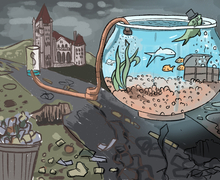BTH : Adding up: College students tally homeless people in their county to help collect federal data
Sheltered by the safety net of a college campus, students sometimes feel a disconnect between campus inhabitants and those who populate the city.
Students from multiple colleges in the East Tennessee area are attempting to close the gap by counting the number of homeless people in the city surrounding their campuses. There are student participants from Carson-Newman College, Maryville College, Walters State Community College and Lincoln Memorial University.
Once students collect their data, they will submit their findings to the U.S. Department of Housing and Urban Development. The department will then determine how to allocate federal funds for local programs, according to a Jan. 26 article in Knox News.
Each county is required to do a one-day homeless count. Jean-Ann Washam, director of Carson-Newman’s Appalachian Outreach program, was appointed as the representative for the area surrounding the school. Because Appalachian Outreach operates the county’s homeless shelter, Washam was asked to spearhead the operation, she said.
Jefferson County, the county where Carson-Newman is located, is a member of the Tennessee Valley Coalition to End Homelessness. Four of the 12 counties represented in the organization have universities within them. Seeing the colleges as a resource, coalition members believed the students would be perfect for performing the count, Washam said.
The count was a ‘point in time homeless count,’ sociology associate professor Ray Dalton said.
‘They knew they weren’t going to contact everyone. There’s no way they can do that,’ Dalton said. ‘They were trying to get a snapshot of homeless population in our county.’
Both Washam and Dalton expressed the difficulty of counting homeless people in a more rural region such as theirs.
‘The face of rural homelessness is much more difficult to count, unlike in large cities with a concentration of people,’ Washam said. ‘That doesn’t mean it’s not occurring. It just means it is less prominent.’
To find the homeless people in their area, students visited places such as underpasses, Laundromats, truck stops, car washes and 24-hour restaurants, Dalton said.
Participation in the count was open to the entire community at Carson-Newman. However, the majority of volunteers from Carson-Newman were students in Dalton’s senior-level sociology class, Washam said. Participating in the count acted as a service-learning component of the course. About 25 percent of the students who participated were regular volunteers at the homeless shelter, Washam said.
To prepare for the count, students in the class and regular volunteers went through training on how to approach the homeless.
As part of their service-learning work, students wrote in a journal about their experiences during the count, Dalton said. The students at Carson-Newman were not alone, as every county in East Tennessee had people counting their county’s homeless population, he said.
Washam said she feels the experience was eye-opening for the student participants, not just about how much homelessness there is in the area, but how many are on the brink of homelessness.
Dalton said he feels the students acted with sensitivity and maturity when dealing with the tough task.
‘It’s a very difficult thing to be sensitive to the needs of other people and to not just look like you’re trying to count people,’ Dalton said.
Having students participate in the count was a huge success and something they would consider doing in the future, Washam said.
‘Students came in with a fresh understanding and enthusiasm to participate and a willingness to go out to the places we sent them,’ Washam said. ‘Because of the sheer number of people we had participate, we were able to do a successful count.’
Published on February 1, 2012 at 12:00 pm
Contact Diana: dspearl@syr.edu | @dianapearl_





